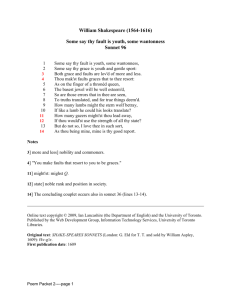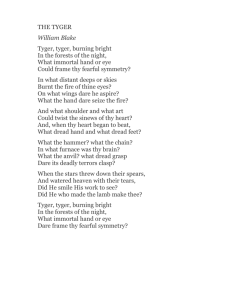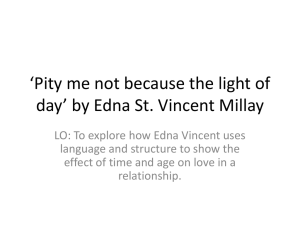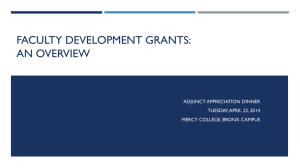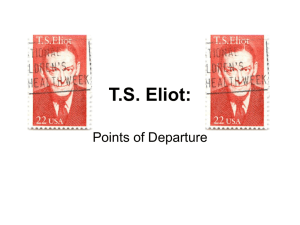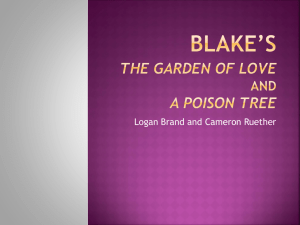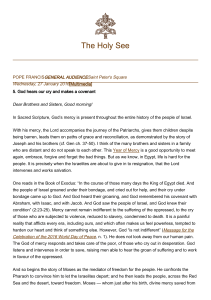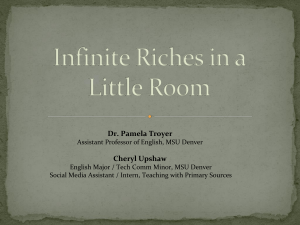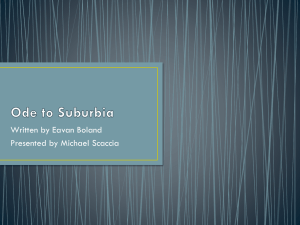File - BaserEnglishProgram
advertisement
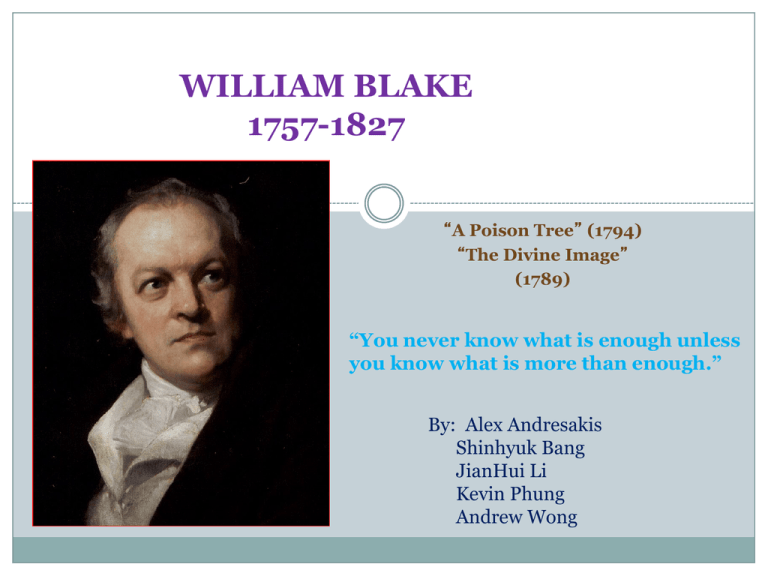
WILLIAM BLAKE 1757-1827 “A Poison Tree” (1794) “The Divine Image” (1789) “You never know what is enough unless you know what is more than enough.” By: Alex Andresakis Shinhyuk Bang JianHui Li Kevin Phung Andrew Wong Biography Of William Blake 2 Date of Birth: November 28th, 1757 Date of Death: August 12th, 1827 (Poverty) Education In 1767 (12) he began study at Henry Pars Drawing Class in the Strand, and in 1771 (14) was apprenticed of engraving. Marriage He married Catherine Boucher. Brother Blake’s brother Robert died. Blake claimed that the spirit of Robert came to him in a vision in the night, and revealed the technique of combining text and pictures on one engraved plate. The Songs of Innocence He hand produced the Songs of Innocence using this new method in 1789 (32) with the help of his wife, having taught her to read and write. The text and illustrations were printed from copper plates, and the illustrations then finished by hand with watercolors. Prophetic books Blake had produced many of his ‘prophetic’ books : The Visions of the Daughters of Albion, America a Prophecy, The Songs of Experience and The First Book of Urizen. A new generation of admirers After 1818 (61) his work found admirers amongst water-colourists of the next generation, particularly John Linnell and John Varley who encouraged him and commissioned works Historical/ Social Background Divine Image: This poem has an historical background to it when it was written by William Blake. In the time this was written, it was a religious period. So the poem was based off some religious principles like mercy, pity, peace and love. "The speaker states that all people pray to these in times of distress and thank them for blessings because they represent “God, our father dear.”(spark notes) If one obtained any one of those virtues, they could be considered divine. Poison Tree: This poem has an historical background also located in a religious time. "Religious dissent in England, which first appeared in 1662 when a group of English Puritans broke away from the Church of England, refusing to take communion in the Church or accept its doctrines and authority, took many forms."(book rags)This poem was written as a way to oppose the Church of England and its practices. 4/13/2015 The Divine Image (1789) BY WILLIAM BLAKE To Mercy, Pity, Peace, and Love All pray in their distress; And to these virtues of delight Return their thankfulness. For Mercy, Pity, Peace, and Love Is God, our father dear, And Mercy, Pity, Peace, and Love Is Man, his child and care. For Mercy has a human heart, Pity a human face, And Love, the human form divine, And Peace, the human dress. Then every man, of every clime, That prays in his distress, Prays to the human form divine, Love, Mercy, Pity, Peace. And all must love the human form, In heathen, Turk, or Jew; Where Mercy, Love, and Pity dwell There God is dwelling too. A Poison Tree (1794) BY WILLIAM BLAKE I was angry with my friend; I told my wrath, my wrath did end. I was angry with my foe: I told it not, my wrath did grow. And I waterd it in fears, Night & morning with my tears: And I sunned it with smiles, And with soft deceitful wiles. And it grew both day and night. Till it bore an apple bright. And my foe beheld it shine, And he knew that it was mine. And into my garden stole, When the night had veild the pole; In the morning glad I see; My foe outstretched beneath the tree. The Divine Image (1789) To Mercy, Pity, Peace, and Love All pray in their distress; And to these virtues of delight Return their thankfulness. We think that mercy, pity, peace and love are necessary for men to attain. They pray to God when in agony, but when they perfect one of these virtues, they pray again with thanks. For Mercy, Pity, Peace, and Love Is God, our father dear, And Mercy, Pity, Peace, and Love Is Man, his child and care. He repeats the line “mercy, pity, peace, and love” purposely to what those virtues represent, our God and his sons and daughters when all virtues are perfected. For Mercy has a human heart, Pity a human face, And Love, the human form divine, And Peace, the human dress. Mercy is done with the decision made in our hearts, or our consciousness. Pity is what we express through our facial expression or our feelings. Love is great and doesn’t have a source, but it is something meant to be. And Peace is Then every man, of every clime, That prays in his distress, Prays to the human form divine, Love, Mercy, Pity, Peace. All men and in all hardship, we pray in agony for help and our answer from God is to perfect all four virtues that men must attain. All men must love men in other forms and every men has And all must love the human form, a divine in them as well. So all four virtues exist in every In heathen, Turk, or Jew; men. Where Mercy, Love, and Pity dwell There God isRhyme dwellingscheme too. is abcd but in stanza 2, “LOVE” and “LOVE” rhymes together. The tone of this poetry is Analysis: confidence with steady beat rhythm. This poetry has a symbolism which are the four virtues which is actually representation of God. A Poison Tree (1794) 7 I was angry with my friend; I told my wrath, my wrath did end. I was angry with my foe: I told it not, my wrath did grow. Blake was angry with a friend of his, but it had settled down. But he was angry with his enemy and his anger did not settle. We think the enemy in this poem is temptation. And I waterd it in fears, Night & morning with my tears: And I sunned it with smiles, And with soft deceitful wiles. His anger grew stronger with fear and his sadness through day and night. He tried to get rid of it with deceiving smiles, but felt guilty of it. And it grew both day and night. Till it bore an apple bright. And my foe beheld it shine, And he knew that it was mine. And into my garden stole, When the night had veiled the pole; In the morning glad I see; My foe outstretched beneath the tree. Analysis: His anger was still growing day and night. That is when he had temptations from his enemy. And his enemy knew he would fall for the temptation. The bright apple represents a golden apple in the Bible. The temptation had tempted him, but he did not fall for it but to get past it and the temptation had gone away. Rhyme scheme is aabb ccdd. This poetry consists of 4 stanzas with 4 lines. The tone is fast and angry and the rhythm is mildly fast. The narrator is ambiguous. This poetry contains symbolism and one example would be the ENEMY which represents bad outcome or temptation. Comparison 8 The two poems don’t share an idea. In The Divine Image Blake describes God, “our father”, as a gentle being. This poem describes human love as something God gives by comparing love as the human form divine. In A Poison Tree Blake talks about how wrath is dangerous if bottled up. In the poem Blake had a more dark style being happy that his foe had died. Significance A poison Tree: This poem express a way to protest the Anglican Church. This poem is heavily based on the emotion of anger as a way to oppose the Anglican Church stifling of anger which he believed would only increase it. The significance of this poem to poetry is that uses allusions to bring out the meaning. This allusions are also biblical references as it was written at a deeply religious period. In reading this poem we learn the importance of allusion in poetry. The Divine Image: This poem which his belief in the divinity of human nature. Mercy, Pity, Peace, and Love are divine attributes to which man may attain."(Songs). It states if one attains any of these attributes, they should become divine. The importance of this poem to poetry is its rhyme scheme. Its structure will help us use rhyme when we write poetry. The Wood Workshop: by Andrew Wong The wood workshop, goes on without a doubt. Laboring with machines, obviously not clean. The wood workshop, never comes to a stop. With the foreman being mean, with the workers in between. The wood workshop, goes on without a flop. With injuries unforeseen, workers obscene. The wood workshop, always churning out props. It's the daily routine, all around the clock. 4/13/2015 What Time Brings us: by Jacky Time is invisible But it brings us a lot It brings us birth But it brings us death It can bring happiness But it can also bring sadness It can bring you to uphill But it can also bring you to down hill It can bring you friends But it also brings enermy It is unpredicable But it is also misteries Time is an advanture to our life Just like we flip the pages through the book 4/13/2015 Billionaire: By ShinHyuk Bang Money, money I spend For my money there is no end Stacks of bills next to my bed Bag of coins near my head I am a billionaire Money, money I spend Have so much I lend To the poor I sent Cannot walk away from. Just can’t I am a billionaire 4/13/2015 Works Cited Bloom, Harold. William Blake. Broomall, PA: Chelsea House, 2003. Scott-Kilvert, Ian. British Writers. New York: Scribner, 1997. Vinson, James, and D. L. Kirkpatrick. Poets. New York: St. Martin's, 1979. Gordon, Todd. Wang, Bella ed. "Songs of Innocence and of Experience Study Guide : Summary and Analysis of "The Poison Tree"". GradeSaver, 31 May 2011 Web. 5 June 2013.
